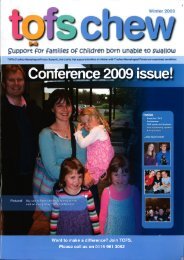Developmental psychopathology
Developmental psychopathology
Developmental psychopathology
- No tags were found...
Create successful ePaper yourself
Turn your PDF publications into a flip-book with our unique Google optimized e-Paper software.
<strong>Developmental</strong> <strong>psychopathology</strong>-risk factors and resilience factors are interdependent in a givenindividual (eg a hostile critical primary caregiver relationshipmay be a risk factor at age 3 and a resilience factor at age 13 in agiven individual)-assessment and treatment involves [1] identifying biological,psychological, social, cultural and developmental risk and resiliencefactors and their relative importance in a given individual and[2] biological and psychological treatments used alone or inconjunction to achieve specific goals informed by the relativepriorities of these risk and resilience factors-monitoring of treatment resides primarily with the clinician inassociation with the individual in the treatment process-clear biological risk factors or resilience factors identified
A useful clinical model for understanding these problemsExecutive functioningResponse inhibition:Working memory:motor and cognitionoptimise response speed and accuracyverbal and visuospatialoptimise span and strategy
A useful clinical model for understanding these problemsMood dysregulation:Arousal dysregulation:decrease irritabilityincrease emotional salienceoptimise physiological arousaloptimise habituation
Useful medication approachesResponse inhibition:motor and cognitionspeed and accuracystimulant medication-linear dose responseclonidine higher doseWorking memory:spanstrategystimulant medication-inverted parabolic responsestimulant medication-linear dose responseclonidine higher dose
Useful medication approachesMood dysregulation:irritabilityemotional saliencestimulant medicationSSRITCAantipsychotic medicationstimulant medicationSSRI?TCA?
Arousal regulation:physiological arousalhabituation responseclonidinebenzodiazepinesTCAantipsychotic medicationclonidinebenzodiazepinesTCA?antipsychotic medication?
-start low, go slow, finish slow, although same optimal dosesare suggested-children versus adults:higher doses with more frequent dosingNB: increased distribution and more rapid clearanceNB: daily compliance issuesNB: non-linear kinetics due to saturation eliminationSSRIs/higher doses sodium valproate
-children versus adults:NB: varying pharmacodynamicsmoclobemide short t1/2 but 18-24 hours ® effectsantipsychotics receptor saturation differencesantidepressants and delayed response,antipsychotics prolonged effects,toleranceat a ® level
Remember-the psychological and social context in which the childis immersed is important as well….-most importantly, we want the child to be in a learningenvironment that is consistent and attuned, sensitive andresponsive…-key developmental phases lead to changes inpharmacokinetic (especially distribution and clearance)and pharmacodynamic (especially short and longer-term® effects at primary and secondary levels) properties-each child needs complete re-review every six months
-impact of development on pharmacokinetics includes:1. increased liver-total body ratio and greater renal clearance-impact of development on pharmacodynamics include:1. unique sensitivity to particular medications at particulardevelopmental phases associated with particular beneficialand/or adverse-effects: aspirin-Reye’s syndrome, tetracyclinedeposition in teeth and bone (Vitiello, 1998)2. host of unknown factors affecting both -kinetics and -dynamicsKey principles of psychopharmacology in childrenand adolescents-increasing use of medication in the treatment ofdisruptive behaviour disorders, obsessive compulsive disorder,and depressive disorders-increasing use of medication in the longer-term-safer medications with better risk-benefit ratios (SSRIs,atypical antipsychotic medication)
Key changes in the central nervous system in childhood andadolescence-synaptic density highest first 3 years with synaptic ‘pruning’ leading toadult levels at approximately 10 years of age-CNS metabolic rate increases exponentially in first 3-4 years, remainshigh until approximately 9 years then gradually decreases to adult levelsin middle to late adolescence-striatal dopamine receptors increase from birth through to 3-4 yearsand then decrease-a rodent model of critical developmental periods:stimulation of 5-HT 1A receptors before puberty only acceleratesphysical and behavioural maturation while depletion of serotoninbefore puberty leads to a permanent decrease in synaptic densityand life-long learning difficulties; NB haloperidol and morphine effects-findings consistent with the general guidance-mechanism hypothesis
-in human beings the primary area of research has been possibleeffects secondary to in utero exposure to different classes ofpsychotropic medication: for example, peri-natal syndromes:phenothiazines-hypertonicity, restlessness, dystonias, parkinsonism;tricyclic agents-irritability-longer-term valid and reliable data has not been collected-medication is used as a facilitating agent within an existingpsychological treatment programme-medication is used to address specific goals rather than to treat aspecific psychiatric disorder-medication is used short-term with ongoing monitoringand thorough review
-ongoing monitoring involves an active treatment record being keptby the young person and/or their parent(s) that involves the specificgoals for medication treatment being assessed on a daily basiswith respect to the preceding day using a –2/-1/0/+1/+2 scale;regular treatment review by the treating clinician and a crisis plan aremandatory-thorough review every six months of the diagnostic and multi-domainformulation (bio-psycho-social-cultural) is necessary to determinethe specific goals for treatment, given a developmental trajectorythat should be charted




